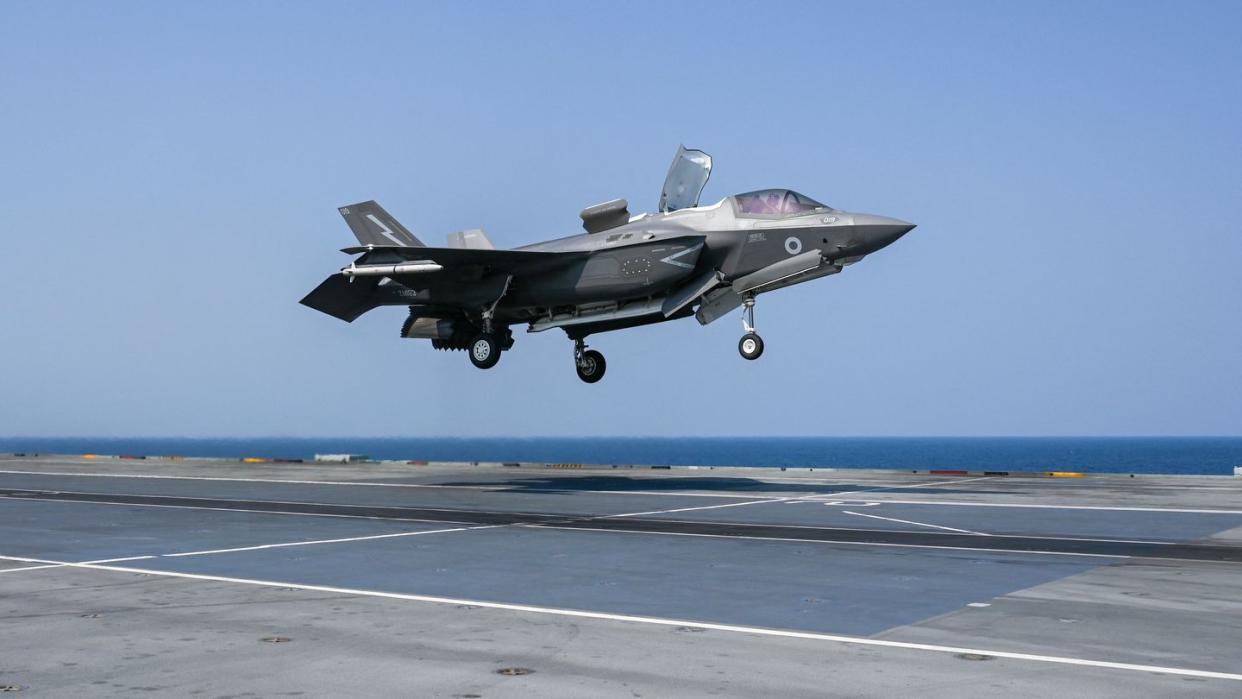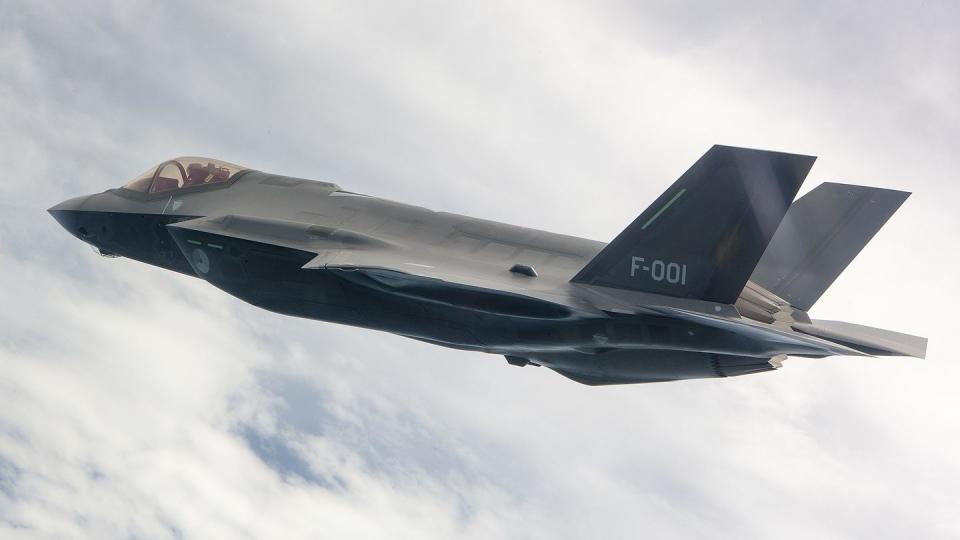Uh, Sir, One of Our F-35s Has Literally Disappeared

One of the U.S. Marine Corps’ advanced F-35B Lightning stealth jump jets has gone missing after its pilot locked it onto autopilot mode and made an emergency ejection while flying over South Carolina on the afternoon of Sunday, September 17. Fortunately, the pilot survived and has been hospitalized in stable condition.
But the status and location of his F-35 remains a mystery—such a mystery that the Pentagon is soliciting tips from civilians to locate it!
Get the latest military news and defense discoveries delivered straight to your inbox.
Sign up for our free newsletter and receive a daily digest of the most exciting science news stories in the world. Subscribe for free.
The F-35B in question was based at Marine Corps Air Station Beaufort, home to Marine Fighter Attack Training Squadron 501, and was flying alongside another F-35B, which returned safely to base. By now the, ‘zombie’ F-35B is certain to have crashed, as it could remain airborne for only a couple hours cruising on internal fuel. But it may have flown a considerable distance—even hundreds of miles—before striking the ground.
There has been some public indignation on the fact the Pentagon was unable to maintain track of the pilotless F-35.
Now that I got that out of the way. How in the hell do you lose an F-35?
How is there not a tracking device and we’re asking the public to what, find a jet and turn it in?— Rep. Nancy Mace (@RepNancyMace) September 18, 2023
Reportedly, the jet’s transponder—which could have been used to geolocate the aircraft—was not functioning for “some reason that we haven’t yet determined,” according to a base spokesman. Perhaps the same inflight ‘mishap’ also suppressed the aircraft’s communication systems.
Of course, as a stealth aircraft, the F-35’s position would inherently be difficult to track non-cooperatively by radar. For both operational security and safety reasons, F-35Bs often fly non-combat missions with ‘Lunenberg Lens’ reflectors designed to increase their visibility to radar, but not it seems on this flight.

And if its fuel was exhausted and it crashed in an unpopulated area, the stealth fighter may not have produced much flame and smoke, allowing the crash site to be easily spotted from afar.
Thus, a joint search effort involving the Marine Corps, Air Force, and South Carolina police is underway, currently focused on the Lake Moultrie area 50 miles north of Charleston, as well as Lake Marion, which is northwest adjacent to Moultrie. That suggests the armed service don’t think the F-35 flew all that far away.
We’re working with @MCASBeaufortSC to locate an F-35 that was involved in a mishap this afternoon. The pilot ejected safely. If you have any information that may help our recovery teams locate the F-35, please call the Base Defense Operations Center at 843-963-3600.
— Joint Base Charleston (@TeamCharleston) September 17, 2023
This the fourth or total hull loss of an F-35B. MCAS Beaufort was also the site of the first-ever F-35 loss in September 28, 2018 in a mishap attributed to a faulty fuel tube. Subsequently, another F-35B crashed after colliding with a KC-130 refueling tanker in September 2020, and the Royal Air Force lost a third F-35B over the Mediterranean Sea in November 2021 from a malfunction caused by an engine plug accidentally left in the intake.
Another F-35B being test-flown prior to delivery to the military experienced an engine malfunction while landing at Fort Worth, Texas, compelling the pilot to perform a zero-altitude ejection. The culprit was vibrations building up a harmonic resonance causing disjunction of a fuel tube. Though heavily damaged, this aircraft appears recoverable, but if not, it would bring the total number of F-35B losses to five.
F-35 crash-lands in Fort Worth, TX - pilot ejected 🇺🇸 #aviation pic.twitter.com/Ov7qXf0xad
— Houston Air Watch 🚁🛰️ (@houstonairw) December 15, 2022
The simpler and more numerous F-35A conventional takeoff jet has suffered three hull loss accidents, while just one of the Navy’s catapult-launched F-35Cs was destroyed when it struck the ramp of the carrier USS Carl Vinson while attempting to land.
Only one pilot fatality—a disoriented Japanese Air Self Defense Force pilot—resulted from these eight hull-loss incidents due to the successful use of ejection systems.
There have been additional accidents that damaged, but didn’t destroy, F-35s, with causes ranging from a forced belly-landing, to exploding cannon shells and combusting engines.
What went wrong?
The Pentagon has yet to indicate what went so wrong with the jet to have compelled the pilot to eject while the airplane was still apparently capable of cruising a significant distance on autopilot.
One intriguing theoretical explanation could be a flaw with the jet’s On Board Oxygen System (which feeds the pilot air from a bottle) and cabin pressurization, which could have endangered the pilot even if his jet remained flyable. In such a scenario, the risk of the pilot passing out or otherwise being incapacitated before he could land might be deemed to merit an emergency ejection.
Difficulties with the F-35’s OBOGS have repeatedly come to the fore in the past decade. In 2017, the Air Force Times reported five different incidents in which Air Force pilots flying F-35As based at Luke Airbase experienced OBOGS failures causing hypoxia or oxygen deprivation, necessitating use of a backup oxygen system.
OBOGS can be disrupted, for example, as one of several effects from a failure of an F-35’s Integrated Power Pack (IPP), which also supplies electricity for cooling and cabin pressurization.
One pilot who experienced an IPP failure who managed to successfully land his aircraft described to The Aviationist the procedure to avoid succumbing to an OBOGS shutdown:
“…descend below 17,000 mean sea level, manually turn on the backup oxygen system, bring the throttle to idle for five seconds, and actuate the flight control system/engine reset switch. These critical steps made sure I wasn’t exposed to any physiological effects from the cabin depressurizing or losing the OBOGS, and hopefully reset the IPP without further troubleshooting.”
He notes IPP failures are “…not common in the F-35, but they do happen from time to time, and we train frequently to emergency procedures in simulators to handle them correctly.”
The F-35B is the most expensive and shortest-ranged of the three variants of the F-35 Lightning, as it incorporates lift fans that allow it to lift off near vertically from the deck of an amphibious carrier or very small airfield. This design was made specifically at the request of the Marine Corps, and has also proven popular with foreign navies for pairing with smaller-sized aircraft carriers formerly only compatible with increasingly dated Harrier jump jets.
However, the vertical-takeoff-and-landing aircraft have always historically involved some sacrifices in performance (due to the bulk of the lift fans) and a higher risk of accidents compared to more conventional designs. Single-engine jets broadly are also more likely to be lost to engine failures than costlier-to-fly twin-engine jets.
More broadly, the F-35 program has long attracted controversy for huge development cost overruns, lengthy delays associated with de-bugging its many novel systems, and high operating costs per flight hour. However, thousands of these jets are on order both on the export market and U.S. military, and the type is benefiting from favorable economies of scale evident when the F-35A’s ‘fly-away’ price roughly matches or falls below non-stealth 4.5-generation jets.
That said, should the investigation systemic implicate flaws in the crash, it may build support in Congress or the Pentagon for reduced procurement rates and/or total orders of F-35 aircraft in favor of investing in successor platforms.
While it may be tempting to assume the recent accident reflects systemic flaws in the F-35, such a conclusion won’t be warranted until we learn more about the specific causes that compelled the pilot to eject. The culprit may indeed be a long-known flaw, or it could arise from a freak incident unlikely to reproduce itself, or factors such as maintenance errors that aren’t intrinsic to the design. Such factors still routinely cause annual attrition of respected and mature prior-generation aircraft, too.
You Might Also Like


